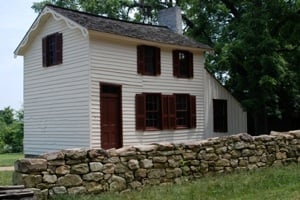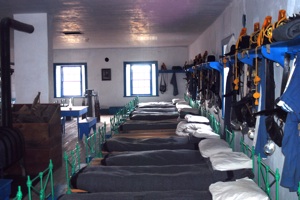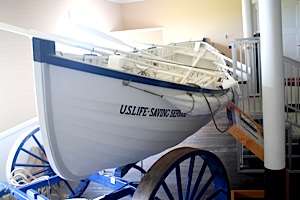History, both protecting vestiges of it and interpreting it, is one of the central missions of the National Park Service. But a new report says the agency is largely failing that mission, both from a lack of investment as well as from an approach to telling history almost with blinders on. As a result, the report says history in the parks is considered to be "endangered."
Those findings, reached by the Organization of American Historians, come in the wake of a similar report from the National Parks Conservation Association that also said the Park Service's history programs and resources were suffering from problems ranging from landscapes being impacted by development and artifacts affected by “decay and damage" to even "outdated scholarship."
The latest study, Imperiled Promise, The State Of History in the National Park Service, was performed at the request of the Park Service. It was prepared by Anne Mitchell Whisnant (University of North Carolina at Chapel Hill), Marla Miller (University of Massachusetts, Amherst), Gary Nash (University of California, Los Angeles), and David Thelen (Indiana University). They reached out to more than 1,500 Park Service staff with some responsibility for history with a questionaire that was completed by 544. Additionally, the study was prepared with insights from retired and current NPS administrators, managers, and "official" historians.
We found that much is going well. Our study identified nearly 150 examples of historical projects and programs that NPS personnel regard as effective, inspiring models. We ourselves observed many instances of high-quality scholarship and creative interpretation. More than a dozen of these successes are profiled herein, as lamps lighting the path ahead.
But we also found that the agency’s ability to manage its sites “unimpaired for the enjoyment of future generations”—let alone achieve its highest aspirations to become the nation’s largest outdoor history classroom—has been imperiled by the agency’s weak support for its history workforce, by agency structures that confine history in isolated silos, by longstanding funding deficiencies, by often narrow and static conceptions of history’s scope, and by timid interpretation.
As a consequence, one of our survey respondents wrote, history in the NPS is “sporadic, interrupted, superbly excellent in some instances and vacant in others.” Our findings describe many specific aspects of the state of history practice today—an uneven landscape of inspiration and success amid policies and practices that sometimes inhibit high-quality work.

The Innis House at Fredericksburg and Spotsylvania National Military Park. Kurt Repanshek photo.
Report: NPS Gives History Short Shrift
Among its criticisms, the report said the Park Service places:
• An under-emphasis and underfunding of historical work as priorities shifted to natural resources, law enforcement, and other concerns;
• An artificial separation of cultural resources management from interpretation;
• An artificial separation of natural resources interpretation from cultural and historical interpretation;
• An overemphasis on mandated compliance activities at the expense of other ways history can be practiced; and
• A misperception of history as a tightly bounded, single and unchanging “accurate” story, with one true significance, rather than an ongoing discovery process in which narratives change over time as generations develop new questions and concerns, and multiple perspectives are explored.
To address these issues, the report suggests that the Park Service organize a History Leadership Council involving "the agency’s most talented and influential historians and interpreters," and a History Advisory Board that would be comprised by "the nation’s leading public history professionals from beyond the agency—the most innovative curators, the most insightful scholars, the most savvy administrators."
"With these two bodies providing much-needed leadership, other needs (dissolving internal barriers and fostering interconnection, better engaging the agency’s own history, and learning of and from some of the most exciting developments both within and beyond the agency) should fall more readily into place," the report said.
More broadly, the report recommends that the Park Service restructure its approach to history. For example, the agency should look beyond its individual park borders when recounting the history of a location, "acknowledge that history is dynamic and always unfinished," recognize the agency's own role in shaping the history of its parks, and don't shy from exploring controversies that occurred in the past as well as those that arise while discussing the past.

Cavalry bunkhouse at Fort Laramie National Historic Site in Wyoming. Kurt Repanshek photo.
Just The Latest Report Criticizing NPS
How the Park Service might respond to the critiques and recommendations in the report is hard to say, although this is not the first report critical of the agency's handling of history. Indeed, some of the criticisms and recommendations made in the OAH report were made as long as a decade ago.
Among other reports that contained criticisms of the agency's approach to history was the National Academy of Public Administration's Saving Our History: A Review of National Park Cultural Resource Programs (2008), the National Parks Second Century Commission's Advancing the National Park Idea (2009), and the National Parks Conservation Association's State of America’s National Parks (2011).
...Some themes emphasized in these recent reports were, indeed, already evident in earlier ones. A decade ago, in a landmark report commissioned by the National Park System Advisory Board, historian John Hope Franklin and his colleagues encouraged NPS to make many of the changes we will recommend herein: to embrace the agency’s educational mission and promise, to expand interpretive contexts well beyond particular parks, and to better integrate understandings of nature and culture. The Franklin report also urged more funding, better support for professional development, and improved scholarship...
Many of the problems stem from a lack of staff dedicated to history in the parks, the OAH report notes. As an example of how dire things are in this area, the report noted that of the Park Service's 22,000 employees, fewer than 200 carry the official title of "historian." And yet, the National Park System is rich with history, from sites protecting landscapes ranging from the Revolutionary War and Civil War to the Civil Rights movement, the Indian Wars, and even the Cold War. It could be argued that the system is richer in history than in scenic landscapes, as history overflows even in the iconic Western landscape parks such as Yellowstone, Yosemite, and the Grand Canyon.
Startlingly, "Unlike at other points in NPS history, neither the chief historian’s office, nor any other single entity within the service, clearly speaks on history’s behalf or has responsibility for overseeing all history work throughout the NPS. Indeed, that fact is one of the issues this report seeks to address."
Dr. Robert Sutton, the Park Service's chief historian, declined comment on the report, relaying through Park Service communications personnel that his staff was "reviewing its findings." Also unanswered was whether -- and if so, how -- the agency was reacting to past criticisms of its approach to addressing history in the park system.
At the NPCA, Catherine Moore, the group's cultural resources program manager, said she has "not seen any indication from NPS that anything to do with Cultural Resources has improved since our report was released last summer."
"But that's not a lot of time for the kind of changes we recommended to be enacted," she added. "They are so desperately trying to keep things from getting a lot worse, budget-wise, that I don't think there's been much opportunity to focus on how to improve conditions."
Dr. Dwight Pitcaithley, the chief historian for the Park Service from 1995-2005, agreed with the OAH report's conclusions.
"Whether the NPS will address the recommendations that will lead to systemic improvements to the history program remains to be seen," he said, adding that the greatest impediment to change in the Park Service is "organizational inertia."
What he meant by "organizational inertia," said Dr. Pitcaithley, is that the Park Service "by and large is comfortable with the status quo."
"I suspect the reason why the NPS has not completely embraced those past recommendations is that real change -- fundamental change of the kind envisioned -- takes a great deal of time and energy and the NPS by and large is comfortable with the status quo," he said in an email. "In addition, life in the NPS is hard from too little money and high expectations from the public and Congress. Employees are working flat out just to stay afloat, leaving little time to think differently about how the agency should develop and monitor its interpretive/educational programs."
Dr. Richard West Sellars, who had a long career as a Park Service historian, agreed with Dr. Pitcaithley that the agency can dig its heels in when it doesn't want to be budged by outside concerns.
"The NPS is indeed tone-deaf whenever it wants to be--so much depends on timing and personalities--not so much on laws, regulations and management policies," he said. "For example, I know you are very familiar with (Paul) Berkowitz's excellent book (The Case of the Indian Trader: Billy Malone and the National Park Service Investigation at Hubbell Trading Post), which exposes more tone-deafness than one can imagine."
But when the agency is led by officials willing to listen, and the message is keen, change can occur, said Dr. Sellars. Such was the case in the wake of his book on how the Park Service conducted science in the park system, Preserving Nature in the National Parks: A History.
"The reason Preserving Nature spurred the Natural Resource Challenge was because it laid out a sound reason for change --AND, most important-- the timing just happened to be good when the book came out," Dr. Sellars added. "For instance,there were people in Washington who were receptive--(then-Director Robert) Stanton, (former Associate Director Mike) Soukup, (then-Deputy Director Denis) Galvin, et al. Without them and others, the NRC would have died in its cradle."
NPS Asked To Revitalize Approach To History
The authors of Imperiled Promise noted that in his Call to Action, a 5-year plan intended to guide the agency to its centennial in 2016, Park Service Director Jon Jarvis requested an update to the Leopold Report that addressed wildlife management in the park system. The authors of the OAH report called on the director to make a similar commitment to history in the parks.

An exhibit on the U.S. Life-Saving Service at Cape Lookout National Seashore. Kurt Repanshek photo.
"Our report constitutes a no less urgent call to reinvigorate history in the NPS, to make the highest quality history research, scholarship, and interpretation central to the agency’s management and even worldview," they wrote.
But the report also doesn't place the shortcomings entirely on the shoulders of the Park Service. The greater community of historians beyond the agency also are somewhat responsible, the report pointed out, for not actively driving home the importance of "sound scholarship" on both the Park Service and other policymakers.
"While we will argue ... that there is much the NPS can do to raise professional standards of history in the agency," the authors of the OAH report said, "we agree that the history profession must also examine itself and find ways to strengthen, support, engage, and partner with the agency most central in the presentation of its work to the American public.
"For far too long, academe’s own culture and structure have prevented many talented scholars from engaging with history in the national parks—in effect reinforcing the insularity that NPS practices build from within, and preventing us from recognizing and nurturing our common purpose. Working together, the profession and the Park Service must face the future as full partners, rearticulating the public and civic role of history."
Dr. Whisnant said the report will be presented to the OAH executive board in April. Hopefully, she said, the board will appreciate and act on "the importance of the ongoing partnership between history scholars and the NPS that helps those of us on the outside to support and encourage the best possible practice of history on the inside."
Can the Park Service change its approach to discussing and exploring history in the parks? Dr. Pitcaithley believes it can.
"I don't believe the agency has become too cumbersome to manage its affairs efficiently. But change of the kind envisioned in this report and the past reports is that, in part, the recommendation will require a change in the organizational culture of the NPS," he said. "And cultural change in any organization is difficult....not impossible, just difficult. When it wants to, the NPS can move quickly to improve its programs. One needs to look no further than the Natural Resource Challenge to see how the agency can change the way it envisions its future."


 Support Essential Coverage of Essential Places
Support Essential Coverage of Essential Places







Comments
Who are you to judge who is and isn't "indigenous" to a place? We all came from somewhere. You do realize that the Hopi only became "The Hopi" around the thirteen or fourteen hundreds? They are decendants of the Pueblo Culture. There are many decendant tribes that come from the Pueblo Culture, NOT JUST THE HOPI. The Pueblo or Hopi as you are calling them, moved into the Southwest somewheres around a couple thousand years ago, so I guess by your standards they are also not indigenous, since they too, came from somewhere else? Again, almost the entire Wupatki Visitor center is dedicated to speaking about the Pueblo Culture, who AGAIN, are the ancestors of the Hopi. Do you really think it is ok to just discount the Navajo history at Wupatki? Just write it off, as if it never happened? What is wrong with interpreting both histories? They both were there. They both had long and rich histories in the area. One sides history isn't more valued or important than the other, no matter what time frame or legnth of time they were there. It wouldn't be fair to say, sorry Navajo, your history here isn't as important as the Hopi's ancestors, so we just won't talk about you. That would be wrong and I am glad that they talk about both at Wupatki.
I hear you Bridge. Sometimes those who are supposed to or feel the need to present themselves as the difinitive source of info don't know the whole picture which is not very often achieved (if ever). It's such a relief to let go of that burden, be humbled and relate to the rest of us in a more personal, effective and truthfull way. Effective Interp presentations are as much about connecting to individuals as information dispersal. Pretty good learning curve involved. The human and Geologic history of the Southwest is facinating in all it's complexities and discoveries are continually being made.
Hey Lee,
I've been at SUCR / WUPA for about 4 years now. I used to hear that this happened regularly even in the few years before I got here. But it just doesn't happen much any more.